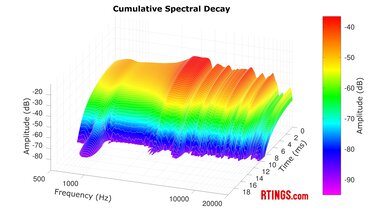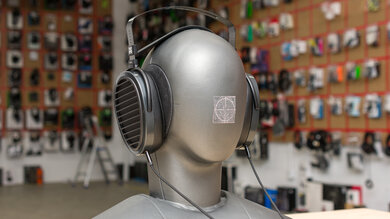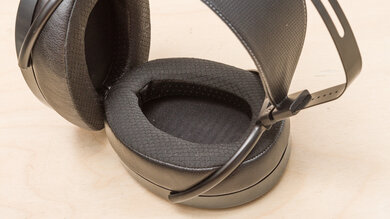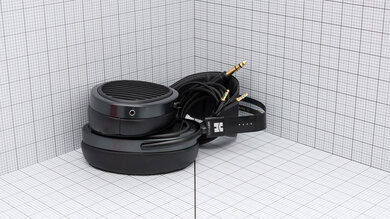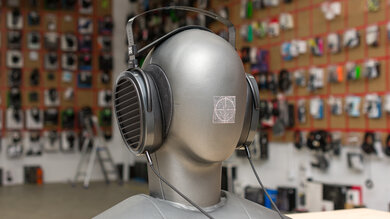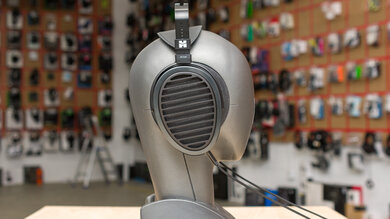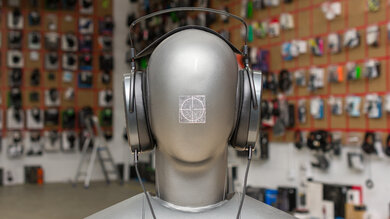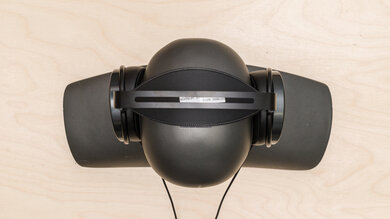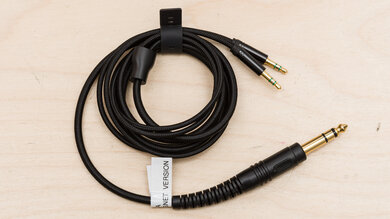The HiFiMan Arya Stealth Magnet Version are version three (also known as Arya V3) of the HiFiMan Arya, high-end planar magnetic headphones intended for audiophiles. This updated model differs from its predecessors due to its namesake stealth magnet design, which the manufacturer advertises improves their sound quality by reducing distortion and increasing transparency. However, their overall design hasn't changed, so they have the same look and feel as their predecessors.
Our Verdict
The HiFiMan Arya V3 are a poor choice for sports and fitness, especially since they aren't designed for this purpose. They're bulky and can easily fall off your head with moderate movement. They also lack an IP rating for water resistance, though that's normal for most headphones.
-
Very comfortable fit.
-
Not designed for portability.
-
Unstable with moderate movement.
The HiFiMan Arya V3 aren't intended for commuting and travel. They're big, bulky, and have an open-back design, so they don't block out any of the low rumble of bus and plane engines. They also leak audio, which can disturb people sitting near you. They don't come with a case either, which can make it easier to damage the headphones when you're on the go. On the upside, they're comfortable and well-built.
-
Very comfortable fit.
-
Bad noise isolation.
-
Leak audio by design.
The HiFiMan Arya V3 are poor for office use. Unless you use these headphones in a private office, you'll annoy coworkers around you since the headphones' open-back design means they'll leak most audio. They also won't block out any background noise, making focusing more difficult. They also don't have a microphone, so you'll need a standalone mic to speak during a meeting or call. That said, they have a comfortable fit suitable for long listening sessions.
-
Very comfortable fit.
-
Bad noise isolation.
-
Leak audio by design.
-
No microphone.
You can't use the HiFiMan Arya V3 wirelessly.
The HiFiMan Arya V3 are adequate for wired gaming. Their open design and good outer ear interaction both help immerse you in intense cutscenes and difficult raids. They're also comfortable, so you can marathon a new release over several hours. That said, they don't have a microphone, so you'll need to find a standalone microphone if you want to chat with friends on Discord or use proximity chat. They also don't come with a 1/4" to 1/8" adapter, so you'll need to buy one if you want to plug the headphones into your PC or console directly.
-
Very comfortable fit.
-
Deliver audio consistently.
-
1/4" to 1/8" adapter not included.
-
No microphone.
The HiFiMan Arya have very good audio reproduction accuracy. For most of the frequency range, they deviate little from their bright sound profile, with fluctuations in the treble causing neighboring frequencies to sound alternately harsh and dull, or piercing and lispy. In a similar fashion, the headphones' L/R drivers are well matched for most of the frequency range, with fluctuations in the treble that can lead to imprecise stereo positioning of high-pitched harmonics. They have low distortion in typical listening scenarios, though astute listeners may perceive some harshness in the mids, depending on the type of content. They also have good pinna interaction, improving the sense of immersion and spaciousness of the headphones' listening experience
The HiFiMan Arya V3 isn't meant to isolate you from your surroundings. Their open-back design allows both the environment to penetrate the headphones, and audio to leak from the drivers to the outside. You'll hear most background noise, and people close to you will hear a thin reproduction of your audio bleed from your headphones.
The HiFiMan Arya V3 don't come with a built-in mic. If you want to record audio or voice call, you'll need another microphone like a standalone mic.
The HiFiMan Arya V3's frequency response consistency is good. If you take the time to set the headphones, your listening experience will generally match our frequency response measurements, even if you wear glasses or have thicker hair. That said, there are minor deviations in the mid-range, though they're not tied to specific characteristics like the size of your head.
- 5.7 Sports And Fitness
- 4.5 Travel
- 3.0 Office Work
- 4.6 Wireless Gaming (In Development)
- 6.7 Wired Gaming (In Development)
Performance Usages
- 7.9 Audio Reproduction Accuracy
- 0.7 Noise Isolation
- 0 Microphone (In Development)
- 7.6 Frequency Response Consistency
Changelog
-
Updated May 20, 2025:
This review has been updated to Test Bench 2.0, which adds the following tests: Stereo Mismatch, Group Delay, Cumulative Spectral Decay, PRTF, Harmonic Distortion, and Electrical Aspects. We've added new performance usages and updated the text throughout the Sound tests and side-by-sides.
- Updated May 14, 2025: We've converted this review to Test Bench 2.0, which updates our sound tests and adds performance usages. You can read more about this in our changelog.
-
Updated Nov 29, 2024:
Several Sound tests have been updated following TB 1.8. There have also been text changes made throughout the review, including to the usages and product comparisons, to match these results.
- Updated Nov 19, 2024: We've converted this review to Test Bench 1.8, which updates our target curve and Sound tests. You can read more about this in our changelog.
- Updated Jul 30, 2024: We've converted this review to Test Bench 1.7, which updates our Noise Isolation test. We've also expanded the scope of this test to include Common Scenarios in addition to Voice Handling and Wind Handling.
Differences Between Sizes And Variants
These headphones are the third generation of the HiFiMan Arya. They come in one color variant: 'Black'; you can see our model's label here. What sets them apart from other Aryas are their stealth magnet design, which the manufacturer advertises improves their sound quality. However, they otherwise retain the same look and feel.
If you encounter another variant of these headphones, please let us know in the forums, and we'll update our review.
Compared To Other Headphones
The HiFiMan Arya V3 are planar magnetic headphones and are the next generation of the HiFiMan Arya. What sets them apart from their predecessor are their stealth magnets, which are supposed to improve sound quality. However, there isn't a significant difference in performance between the two headphones, and the V3 model have a slightly worse distortion performance, though it's still quite good overall. That said, you may enjoy these headphones if you're looking for audiophile headphones that can produce a bit more low-bass than other open-back headphones like the Sennheiser HD 800 S.
If you're looking for more audio-centric headphones, check out our picks for the best audiophile headphones, the best open-back headphones, and the best headphones for music.
The HiFiMan Edition XS and the HiFiMan Arya Stealth Magnet Version are both high-end planar magnetics. While both headphones have similarly open and spacious soundstages, the Edition XS have a slightly punchier and thumpier bass, but overall, they both sound alike. They also come with a 1/4" adapter and have a lower impedance of 18 ohms with a sensitivity of 92 dB, so they're easier to drive. That said, the Arya are more comfortable and feel better built, so it depends on your sound preferences.
Whether the Sennheiser HD 800 S are better open-backs than the HiFiMan Arya Stealth Magnet Version depends on your sound profile preferences and your budget. While both headphones are very comfortable and provide an open sound, the Sennheiser are better-built and lighter in weight, thanks to their dynamic drivers. That said, they're harder to drive than the HiFiMan. Conversely, you may still prefer the HiFiMan if you want your open-backs with a bit more bass.
The HiFiMan Sundara 2020 and the HiFiMan Arya Stealth Magnet Version are both open-back planar magnetics from the same manufacturer. The Arya Stealth Magnet Version can reproduce more low-bass, which some users may prefer. They also have a more premium build. That said, the Sundara 2020 have a warmer treble response that you may prefer if you're sensitive to bright transients like cymbal hits.
The HiFiMan Arya Stealth Magnet Version are an updated model of the HiFiMan Arya. The Stealth Magnet Version have their namesake used in their driver design. The manufacturer advertises that these Stealth Magnets help sound reproduction and lower distortion. That said, there isn't a difference in design, so you can expect the same levels of comfort and build quality. The differences in sound quality are also somewhat minor, as they have largely similar sound profiles and soundstages. However, the Stealth Magnet Version have some distortion present in the left driver at high volumes.
Test Results
The HiFiMan Arya V3 have a sound profile that suits a variety of content thanks to a slightly bright tuning that doesn't exaggerate or de-emphasize any frequency too much. Like most open-backs, there's a roll-off in the low-bass. As a result, their sound signature more closely resembles the SoundGuys.com Studio Curve due to their flatter low-end.
These over-ears have good frequency response consistency. If you take the time to ensure a good seal, the headphones will deliver consistent audio. That said, there's more variation in audio delivery in the mid range depending on your fit, though it's not very significant. While our graphs show more notable deviations in the treble, physical characteristics like ear canal shape can significantly impact audio delivery in these frequencies. This makes our measurements in this range less effective at forecasting your listening experience.
The bass target compliance is remarkable. The headphones lack some low- to mid-bass, which isn't surprising given their open-back design. That said, they aren't missing much, especially considering the performance of other similar headphones like the HiFiMan Sundara 2020. They also have a bit of high-bass emphasis to compensate with some extra warmth.
Their mid-range's target compliance is excellent. The response is slightly tilted with a bit more low-mid emphasis that can clutter busy mixes a tad. Vocals and instruments like the piano in Claude Debussy's Arabesque No. 1 sound natural, though slightly weakened and lacking a bit of intensity in the higher registers.
Their treble target compliance is fantastic. Throughout the range, the frequency response doesn't deviate drastically from the target, resulting in clear-sounding harmonics. The low-treble is slightly subdued, veiling vocals and instruments a bit. The mid-treble is overemphasized, so sibilants like cymbals are bright, though they may be somewhat piercing if you're sensitive to this frequency range.
The peaks and dips performance is good. Overall, the headphones' frequency response deviate little from their bright sound profile. The bass and mids are smooth with few deviations. A dip in the high-mid weakens vocals and instruments a touch. The treble is less even; a peak in the low-treble makes vocals sound somewhat harsh, followed by a narrow dip that can hurt the intelligibility of vocals, depending on the pitch. A series of small peaks and narrow valleys render sibilants like S and T sounds alternately somewhat dull and piercing.
These headphones' L/R drivers are decently matched. Most instances of amplitude, frequency, and phase response mismatch are in the treble range. As a result, you likely won't notice the fundamentals frequencies of instruments and vocals shifting from the center. Additionally, we lose sensitivity to the higher regions of the treble, so fluctuations in the affected bands likely won't be audible. That said, high-pitched harmonics from hi-hats and whistle notes in the low- and mid-treble may sound less precisely positioned in the stereo image.
The group delay performance is very good. You'll experience tight bass and transparent treble.
The HiFiMan Arya Stealth Magnet Version's PRTF measurements indicate good amounts of pinna interaction. Their listening experience somewhat resembles the qualities of an angled stereo speaker setup, improving your sense of immersion.
The HiFiMan Arya Stealth Magnet Version have great harmonic distortion performance. At typical listening levels, you likely won't perceive any coloration caused by distortion. Although the headphones product harmonic distortion in the bass, you likely won't notice audible coloration as we're less sensitive to lower frequencies. However, the most sensitive listeners may notice slight harshness caused by distortion in the mid and treble.
These headphones don't require an amp to drive them. You can listen to them at high levels when connected to a mobile device or laptop.
These are the settings used to test the HiFiMan Arya V3. Our results are only valid when used this way.
These headphones look similar to the HiFiMan Arya (also known as the Arya V2). They still have oblong ear cups with dark silver grilles to protect their drivers. They also have a ski-band headband design and a tall metal headband to hold the headphones together. What makes these headphones different from the V2 model is a change to their driver design. They're still planar magnetic but use stealth magnet technology. The manufacturer is vague on what this means other than claiming that it improves acoustic transparency and reduces distortion. They also appear shaped and positioned to create as little interference as possible. They only come in one color variant: 'Black'.
They're comfortable headphones. Even though they're pretty bulky, their headband helps distribute the headphones' weight, so you can wear them for long listening sessions without feeling fatigued. Their spacious ear cups also ensure a solid seal, even if you have large ears, and the padding feels plush without putting too much pressure on your head.
These headphones aren't designed with portability in mind. While the ear cups can swivel to lay flat, they can't fold into a more compact shape. They also lack a carrying case to help protect them from damage on the go.
The HiFiMan Arya V3 have a good build quality. They're made of a mix of metal and plastic, which helps them feel sturdy and well-built. They also have faux leather padding. They're basically the same in frame as the HiFiMan Arya.
These headphones aren't designed to block background noise since they have an open-back design that lets sound it. If you want to use them anywhere that's not a quiet, isolated room, you'll hear everything around you.
These headphones are meant to leak audio by design. That means if you're listening to audio, even at moderate volumes, others around you can hear it.
These headphones come with a TRS cable with two 1/8" connectors for the drivers and a 1/4" connector for your device. There are specific connectors for the left and right drivers, so be sure not to mix them up. They lack an 1/4" to 1/8" adapter though.
These headphones are only directly compatible with your PC if you have a 1/4" to 1/8" TRS adapter, and you'll only receive audio.
You can only receive audio via analog on PlayStation consoles if you have a 1/4" to 1/8" TRS adapter.
You can only receive audio when you use their analog connection. However, you'll still need a 1/4" to 1/8" TRS adapter to use them on this console.


